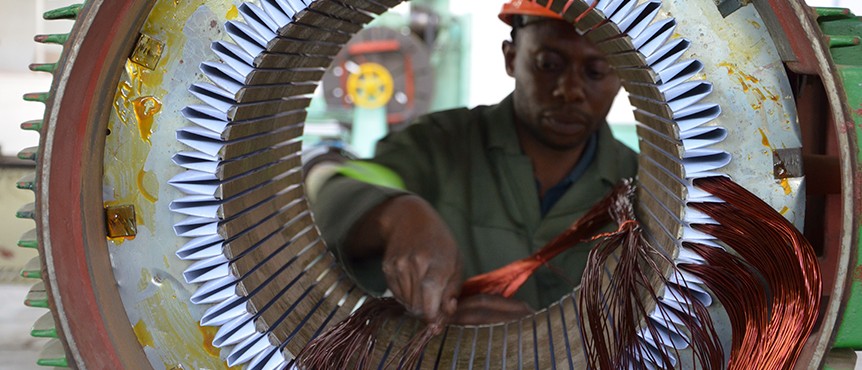Once the mining capital of Africa, South Africa’s decline in regional hegemony is inextricably linked to its fraught sociopolitical fabric.
An Industry in Decline: Understanding the Politics behind South Africa’s Downfall

Image courtesy of Forrest Group
More than a quarter-century after the first democratic election, South Africa’s political, economic and social landscape is still pitted with the shards of apartheid. What is worse, the current trajectory of the country that is marked by rising inequality, staggering unemployment rates, economic decline and political instability is a testament to the reversibility of the nation’s hard-earned progress. The ANC, a coalition once unified by the necessity for resistance, today faces the challenge of mending its internal fragmentation that has South Africa careening towards destruction.
Consumer Capitalism
The 1960s and the early 1970s were boom years for the South African economy. During the first half of the 1970s, foreign investment averaged 14% of gross domestic investment and peaked at 24.5% in 1975-76, while, from 1961 to 1974, average GDP growth was 5.3%. During this period, the white population enjoyed rapidly increasing standards of living, a benefit denied the black majority. International calls for the end of apartheid had been mounting throughout the 1970’s and reached new heights in 1986, when the Comprehensive Anti-Apartheid Act was passed in Washington with enough votes to override a Reagan veto. By 1991, 28 states, 25 counties, and 91 cities had taken economic action against corporations with investments in South Africa, at a cost to South Africa of some US$20 billion.
The socially distorting effects of the apartheid system led to calls for reformation to remedy the inequitable situation and, in 1994, it seemed for a while that a welfare state was underway. Under Nelson Mandela’s leadership, the ANC managed to overcome its internal disagreements over key economic policies and opened up the economy. Foreign investment shot up, growth slowly returned and big business was transferred to the majority through black economic empowerment. “It was, in a way, a grand bargain,” said Claude Baissac, CEO of consultancy firm Eunomix. “The ANC would stay clear of a socialist turn in exchange for economic opening, while government invested in education, housing, health and basic social infrastructure for the long-neglected majority.”
The year 1994 reflected a recovery for the economy of South Africa, with a real GDP growth of 2.4%. In 1995, the government signed a new General Agreement on Tariffs and Trade (GATT) and joined the World Trade Organization (WTO), committing itself to neo-liberal policies. The ANC’s policies were successful in numerous areas. It implemented an extensive welfare system with free health care for pregnant women and children, a free-meal program for school children and access to health care dramatically improved with the construction of 500 new clinics. In addition, more than two million additional homes were connected to the electricity network. The reforms also resulted in a substantial increase in both imports and exports, the budget deficit fell and South Africa embarked on a period of relatively high economic growth.
The economic growth was, however, not enough to perceptibly reduce the level of unemployment. The black middle-class was significantly expanded with the implementation of Black Economic Empowerment (BEE). This growth increased the demand for trained professionals, whose numbers were strained by emigration due to violent crime, but failed to sufficiently address unemployment amongst the unskilled bulk of the population. The new economic landscape – characterized by decreased low-skill employment in agriculture, mining and manufacturing and higher employment in the service industry and government – excluded those on the bottom of the social hierarchy. For example, the share of semi-and-unskilled labor in manufacturing employment, decreased from 60% in 1980, to 54% in 1990 and 49% in 2009. As confidence in the trickledown effect of neo-liberal policies waned, the prospects of a strong South African welfare state took additional blows throughout the mid-2000s. The leftist faction of the ANC – remnants of the communist party that had been the engine of ideas during the liberation struggle – seized the opportunity to expand their influence, culminating in a transition of power from Thabo Mbeki to Jacob Zuma.
The ANC
In the last decade, South Africa has drifted further and further away from Mandela’s vision of a modern country at peace with itself. Jacob Zuma’s presidency was marked by seemingly endless corruption scandals, overspending, reduced private sector autonomy and plunging investor confidence. Walking backward in its footsteps, with growing inequality (especially amongst blacks), police brutality, rampant infectious diseases and failing education, South African society has reacquired many of the hallmarks of the apartheid era. This regression was not inevitable, but the unity forged by the unlikely figure of Nelson Mandela was fragile and demanded continued growth and the resolution of the stubbornly high unemployment rates. When the live-and-let-live approach to business proved inadequate to resolve these issues, the fault lines along Mandela’s Long Walk to Freedom began to show.
“The ANC itself has never resolved the fundamental debate between its left wing and its right,” Baissac said. “On one side the conservative majority of the urban and rural middle classes. On another the urban industrial and services working class. On yet another, the intellectual elite, mainly white and communist – mostly a dying remnant that is still influential on a vainglorious and failing industrial policy.”
The resistance to apartheid was the glue that held together a political party otherwise defined by internal incoherence. While the ANC continues to function as government and opposition all at once, the noble aspirations set out in the Freedom Charter have increasingly been swapped for a political agenda characterized by government attempts to increase its power relative to civil society. During the years from 1996 to 2008, the international price of minerals – South Africa’s main export – experienced a steep increase. The commodity supercycle, driven by the industrialization of major Asian countries such as China, was expected to continue for several decades and the ANC saw this era of impending prosperity as a good time to reward its political constituency. In 2012, Jacob Zuma earned more than both the German chancellor and the prime minister of the UK. The BEE laws, which had initially worked to expand South Africa’s middle class, simultaneously created a wealthy black political elite through corporate co-opting of former black resistance leaders and heads of trade unions. Since 1996, workers employed in the public sector experienced the highest growth in median real monthly wages of all sectors. In addition to this, the public sector was one of the largest proportional contributors to employment growth over the 2001 to 2012 period. Meanwhile, the underclass – the country’s largest social class and the bulk of the ANC electorate – was fed crumbs in the form of social welfare grants. The increased welfare grant spending, mounting from R2 million in 1996 to R13 million in 2008, combined with higher spending on the state bureaucracy and slashed tariff protection for South African industries, led to a consumption revolution partly fueled by the creation of credit and improved tax collections.
The party ended in 2008. Global recession took hold and South Africa woke up to a reality in which the country’s mining industry had actually shrunk and manufacturing was in steep decline. While the international sanctions during the 1970s and 1980s were a knock to the South African economy, it also resulted in a certain level of self-sufficiency. “We were forced to develop even more local manufacturing capabilities and this industry became so big that it became one of the major driving forces of the local GDP,” related Ossie Carstens, CEO and program manager at manufacturing organization MEMSA. “In the early 1990s, after the release of Nelson Mandela, South Africa was exposed to the global market and the ease of doing business on a global scale. The country was welcomed back into international markets and the protected competitive edge (which was artificially bolstered with sanctions) that local manufacturers had, started to disappear, and it signaled the start of the local manufacturing industry’s decline.”
The decline in manufacturing’s share of employment accelerated from 1995 with the implementation of the government trade reform program. By 2009, manufacturing accounted for a mere 12.5% of non-agricultural employment and by 2016, the manufacturing sector had shed an additional 50,000 jobs. The consumer revolution resulted in the transfer of resources from the production sector to the government and private household consumption – fueling unemployment while creating artificial economic growth. To keep society afloat, a faux capitalism was adopted driven by loans and imports. Furthermore, South Africa’s trade liberalization coincided with China’s rapid integration into the world economy. With manufacturing capabilities in a nosedive and technology lagging, South Africa has so far been one of globalization’s casualties rather than profiting from cheaper high-quality products. In the last two decades, export growth has failed to keep pace with GDP and import growth, resulting in an increased trade deficit that reached 3.4% of GDP in 2008 and 3,5% in 2018.
The New Battle Lines and The Future of South Africa
Through self-defeating policies, corruption and self-enrichment, the South African government has effectively shed its responsibilities while retaining its rights. The ANC’s internal fragmentation has rendered the party in gridlock over key issues such as fiscal policies, health care and land reform. More broadly, the internal contradictions and deadlocks of the ruling party are reflected in a population divided along redrawn battle lines. The economic elite, that owns the country’s productive assets, is vulnerable to state power in forms of asset seizures and control over state-monopolized necessities such as power and infrastructure. Meanwhile, the political elite lacks ownership of productive assets and skills while being heavily dependent on the votes of an increasingly frustrated underclass. The minority blue-collar class finds itself sandwiched between the economic and political elite; excluded from the consumption revolution, left out of communication with the state and constantly under the threat of unemployment. The result of the entailing policy congestion is the draining of public confidence, especially on behalf of the nation’s most vulnerable.
A clear example of the growing tensions between the country’s working class and the state was the 2012 massacre in Marikana where 34 striking mineworkers demanding a wage increase were gunned down by police. The scene, that evoked memories of the country’s darkest days, was a testimony to the reversibility of democratic progress and an ominous forecast for how the government might react to broader social dissent. The underclass, too, is losing patience. Save from a brief pause between 1994 and 1997, protests have been commonplace in South Africa since the 1970s – especially in townships and shack settlements – and have been rising in the last decade. Violent crime initially decreased after democratization but the downward trajectory has shown a reversal in recent years, climbing from 30 per 100,000 in 2011 to 36 per 100,000 in 2017. According to the UN report, possible drivers of the increase in homicide rates include an increase in public protest and political turmoil stemming from perceptions of state corruption and popular frustration with slow provision of resources. Since 1994, some 500,000 people have been murdered in South Africa – some 130,000 more than those killed during eight years of war in Syria.
The main question today is whether the newly elected Cyril Ramaphosa has inherited a state just broken, or broken beyond repair. The former anti-apartheid activist and businessman has pledged to revamp the economy and restore the sheen of the Mandela and Mbeki eras. The way forward: economic growth. But engineering economic recovery will firstly require pushing through policy within a party locked in an internecine zero-sum factional war. Secondly, economic growth will have to translate into reduced inequality. In 2019, unemployment officially reached a 15-year high of 27.6%, but compounding that is another 10% of the population who have stopped looking for jobs. From one end of the telescope, the elite attributes high unemployment rates and inequality to a low-growth economic trajectory while, on the other end, a majority underclass sees it as the result of longstanding systematic exclusion. This former, and widely held viewpoint on behalf of the elite is likely to make them less keen on the economic reforms needed to appease an underclass that is fed up with depending on state philanthropy.
While the hurdles are discouragingly high, South Africa does, however, have some good things going for it. The country’s constitution, largely considered sacrosanct by the population, has so far passed all tests of robustness. South Africa also has the most sophisticated economic infrastructure on the continent with mechanisms in place to mobilize capital and drive economic activity. The country is globally integrated, meaning that lowered financial barriers and policy predictability is probably enough to attract substantial foreign investment.
Ramaphosa will not be able to replicate Mandela’s miracle of unification, and the era when the ANC can form policy solely for electoral purposes has ended. The way forward is to leverage majority support to drive through viable economic policies. With scarce fiscal resources and dwindling popular trust, resolving inequality and unemployment will have to be a priority – otherwise, the combination of high youth unemployment, poor educational outcomes and rampant inequality will eventually result in large-scale social disorder. The tightrope march between the revolutionary redistributive pressure of the citizens and the counteracting forces of the elite will be tough to manage. But, hopefully, the ill-boding socioeconomic trajectory of South Africa has sent a clear enough signal that all parties need to compromise for the purpose of self-preservation.










